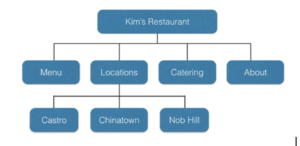How to Optimize Your Website Structure for SEO
Not all website structures are favored equally by search engine algorithms. A site that is a disorganized jumble mess of pages is unlikely to rank well against a structure that is rigorous and streamlined. To make your site structure SEO-friendly, it has to appeal to users while guiding them to relevant content across your website.
Learn more about website structure, why it matters and steps to take to optimize yours for SEO.
What is Site Structure?
Site structure refers to the way a site’s content is grouped, interconnected and presented to its visitors. Website structure starts with a foundation, its home page, then splits off into other sections, such as the about page, contact page or blog page.
Why Does Site Structure Matter?
Site structure is one of the most crucial components linked to SEO performance. A well-executed website structure sets you up for SEO success down the road. It also:
- Creates a better user experience.
- Helps with crawlability.
- Provides you with sitelinks.
How to Optimize Your Website Structure for SEO
1. Plan your site hierarchy.
The hierarchy of your site is the system that arranges your pages from top to bottom. A website’s structure is similar to a skyscraper. It would be difficult to revise the foundation once you’ve already constructed the middle floors. Which is why it’s best to establish the organization of your website from the beginning. Here are some tips to keep in mind when planning out your hierarchy:
- Make it logical. You don’t want to overcomplicate this process for both your sake, your users’ sake and for crawlability. Each main category should be unique and distinct. Subcategories should somehow be related to the main category under which it’s located.
- Keep the number of main categories between two and seven. There should only be a few main aspects of your website. If there’s more than seven, you may want to rethink the structure.
- Try to balance the number of subcategories within each category. You want to keep it approximately even. If one main category has a large number of subcategories, while others only have a few, the site can become unbalanced.
2. Create a URL structure that follows the navigation hierarchy.
URL structure also impacts rankings in Google. Your URLs should follow your website structure, as well as be simple and readable. So if your hierarchy looks like this:

The URL structure for the Chinatown location should look like: www.kimsrestaurant.com/locations/chinatown
More developed sites might contain a longer series of folders and subfolders, but the main idea is to create a concise URL with recognizable words.
3. Select the right navigational depth.
The structure of your site determines how difficult it is to click to a different part of your site. You don’t want important pages of your site to be buried too deep. Shallow paths perform best from a usability and crawlability perspective. With that being said, you also don’t want to go with a completely flat structure. You want a site that proceeds deeper than a second tier of folders, but you want users to be able to get where they need within a few steps.
4. Establish a header and footer.
Headers and footers help enhance website structure by making navigation more seamless. Best practice is to display your main categories in your header, but you can also include dropdown features that show subcategories. When you do incorporate additional features, it’s important they have an easy-to-follow design. Basic text links and corresponding anchors are a reliable way to enrich your SEO strategy. Text links perform well because search engine bots can comprehend them. Although images have ALT text, text links continue to deliver better results when it comes to SEO.
If you have a footer with menu links, be sure they’re duplicated exactly like the main menu links. Changing the order of links or adding additional category listings will complicate the user experience.
5. Include internal linking.
Internal linking shows the relationship between pages and content on your website. Search engine crawlers move from one link to the next, on-site links give search engines a better picture of what your site has to offer. Placing links organically throughout blogs, product/service pages and other posts forms a grid for users to explore. If there’s a related page or helpful link on your blog, users can continue to traverse your site and come closer to converting or purchasing a product. Internal link structures also help crawlers understand the content you think is most important, which supports differences in ranking on search results pages for similar content. Try to link back to your most popular or important pages to instill more ranking value in them for powerful SEO optimization.
Final Thoughts
Site structure is something that can be easily overlooked if you’re not experienced in site building, but it’s crucial when it comes to SEO. At Onimod Global we specialize in both web site development and SEO. You can rely on us for new project development, website maintenance, and more. We build all of our sites with search engines rankings in mind. We analyze data from Traffic Sources and Visitor Flow to establish the routes people take to reach you, the devices they use to get there and what they do on your website. Utilizing this information allows us to build highly engaging, search friendly websites for your business.










